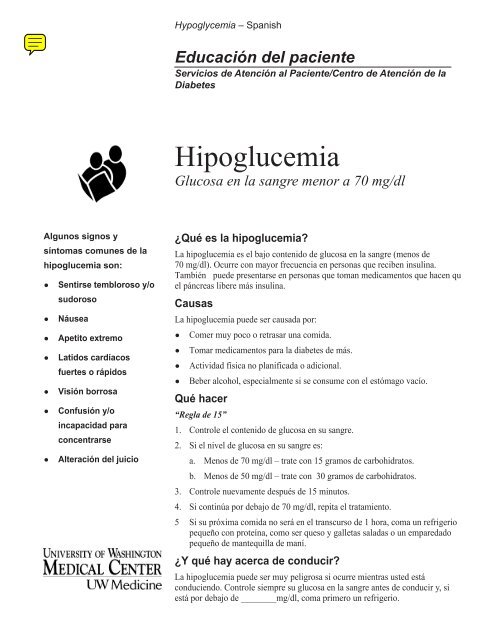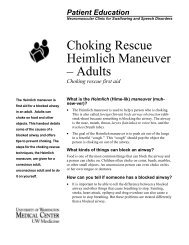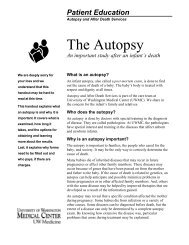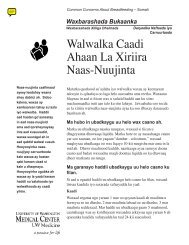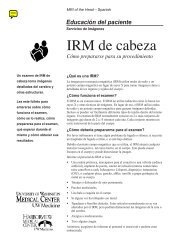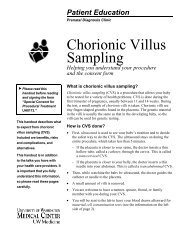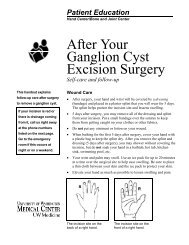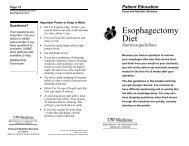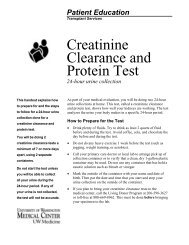Hipoglucemia - UWMC Health On-Line - University of Washington
Hipoglucemia - UWMC Health On-Line - University of Washington
Hipoglucemia - UWMC Health On-Line - University of Washington
You also want an ePaper? Increase the reach of your titles
YUMPU automatically turns print PDFs into web optimized ePapers that Google loves.
Hypoglycemia – SpanishEducación del pacienteServicios de Atención al Paciente/Centro de Atención de laDiabetes<strong>Hipoglucemia</strong>Glucosa en la sangre menor a 70 mg/dlAlgunos signos ysíntomas comunes de lahipoglucemia son:• Sentirse tembloroso y/osudoroso• Náusea••Apetito extremoLatidos cardíacosfuertes o rápidos• Visión borrosa• Confusión y/oincapacidad paraconcentrarse¿Qué• Alteración del juicioes la hipoglucemia?La hipoglucemia es el bajo contenido de glucosa en la sangre (menos de70 mg/dl). Ocurre con mayor frecuencia en personas que reciben insulina.También puede presentarse en personas que toman medicamentos que hacen quel páncreas libere más insulina.CausasLa hipoglucemia puede ser causada por:••••Comer muy poco o retrasar una comida.Tomar medicamentos para la diabetes de más.Actividad física no planificada o adicional.Beber alcohol, especialmente si se consume con el estómago vacío.Qué hacer“Regla de 15”1. Controle el contenido de glucosa en su sangre.2. Si el nivel de glucosa en su sangre es:a. Menos de 70 mg/dl – trate con 15 gramos de carbohidratos.b. Menos de 50 mg/dl – trate con 30 gramos de carbohidratos.3. Controle nuevamente después de 15 minutos.4. Si continúa por debajo de 70 mg/dl, repita el tratamiento.5 Si su próxima comida no será en el transcurso de 1 hora, coma un refrigeriopequeño con proteína, como ser queso y galletas saladas o un emparedadopequeño de mantequilla de maní.¿Y qué hay acerca de conducir?La hipoglucemia puede ser muy peligrosa si ocurre mientras usted estáconduciendo. Controle siempre su glucosa en la sangre antes de conducir y, siestá por debajo de ________mg/dl, coma primero un refrigerio.
Servicios de Atención al Paciente/Centro de Atención de la Diabetes<strong>Hipoglucemia</strong>: Glucosa en la sangre menor a 70 mg/dl¿Qué debo hacer si unmiembro de mi familia seha desmayado debido ala hipoglucemia?Llame al 9-1-1. No tratede darle a la personanada por vía oral.Si tiene un equipode glucagón y sabecómo utilizarlo, podríaadministrarlo.¿Preguntas?Sus preguntas sonimportantes. Si tienepreguntas o inquietudesllame a su médico oproveedor de atención ala salud. El personal de laclínica <strong>UWMC</strong> también seencuentra disponible paraayudar. Si usted es paciente enel Centro de Atenciónde la Diabetes, llame al206-598-4882 Otros pacientes, porfavor llamen a suproveedor de atención ala salud:___________________al _________________Patient Care Services1959 N.E. Pacific St. Seattle, WA 98195Tratar la hipoglucemia•NO trate la hipoglucemia con comidas de alto contenido de grasa,tales como barras de chocolate, galletas o helados. La grasa retarda laabsorción de los carbohidratos en estos alimentos.• Infórmele a su proveedor de atención a la diabetes si padecehipoglucemia grave o frecuente.Fuentes rápidas de 15 gramos de carbohidratosFuente de carbohidratosTabletas de Glucosa *1 tableta = aproximadamente5 gramos de carbohidratos;lea la etiquetaCantidadDe 3 a 4tabletasCarbohidratos(gramos)Calorías15 60Jugo de fruta ½ taza 15 60Refrescos (no de dieta) ½ lata 20 70Azúcar1 cucharilla = 4 gramos decarbohidratos1 cucharada 15 60Bebidas deportivas 1 taza 15 60Leche, sin grasa 1 taza 12 90Leche, 1% 1 taza 12 105Lifesavers1 unidad = 2.5 gramos decarbohidratosSweetTarts *1 unidad = 1.7 gramos decarbohidratosSweetTarts masticables *1 unidad = 0.5 gramos decarbohidratosSkittles1 unidad = 0.9 gramos decarbohidratosFruit Roll-Ups1 rollo = ½ onza; lea laetiquetaPasas de uva6 unidades 15 608 14 6030 15 6015 15 601 12 a 15 50 a 752cucharadas15 60* El primer ingrediente en estos productos es la dextrosa. La dextrosa elevala glucosa en la sangre más rápidamente que otros tipos de azúcar.© <strong>University</strong> <strong>of</strong> <strong>Washington</strong> Medical CenterHypoglycemiaSpanish10/2007 Rev. 04/2009Reprints: <strong>Health</strong> <strong>On</strong>line
Patient EducationPatient Care Services/Diabetes Care CenterHypoglycemiaBlood glucose less than 70 mg/dLSome common signs andsymptoms <strong>of</strong> hypoglycemiaare:• Feeling shaky and/orsweaty• Nausea• Extreme hunger• Heart pounding or racing• Blurred vision• Confusion and/or inabilityto concentrate• Impaired judgmentWhat is hypoglycemia?Hypoglycemia is low blood glucose (less than 70 mg/dL). It occurs most<strong>of</strong>ten in people who take insulin. It can also occur in people who takemedicines that make the pancreas release more insulin.CausesHypoglycemia can be caused by:• Eating too little or delaying a meal.• Taking extra diabetes medicine.• Unplanned or extra physical activity.• Drinking alcohol, especially if consumed on an empty stomach.What to Do“Rule <strong>of</strong> 15”1. Check your blood glucose.2. If your blood glucose level is:a. Less than 70 mg/dL – treat with 15 grams <strong>of</strong> carbohydrate.b. Less than 50 mg/dL – treat with 30 grams <strong>of</strong> carbohydrate.3. Check again after 15 minutes.4. If still less than 70 mg/dL, repeat treatment.5. If your next meal is not within 1 hour, eat a small snack with protein,such as cheese and crackers or a small peanut butter sandwich.What about driving?Hypoglycemia can be very dangerous if it occurs while you are driving.Always check your blood glucose before driving, and if it is under______mg/dL, eat a snack first.
Patient Care Services/Diabetes Care CenterHypoglycemia: Blood glucose less than70 mg/dLWhat should I do if myfamily member haspassed out fromhypoglycemia?Call 9-1-1. Do not attemptto give the personanything by mouth. If youhave a glucagon kit andknow how to use it, youmay administer it.Questions?Your questions areimportant. Call yourdoctor or health careprovider if you havequestions or concerns.<strong>UWMC</strong> clinic staff arealso available to help. If you are a patient atDiabetes Care Center,call: 206-598-4882 Other patients, pleasecall your health careprovider:_________________at ________________Treating Hypoglycemia• DO NOT treat hypoglycemia with high-fat foods such as chocolatecandy bars, cookies, or ice cream. Fat slows the absorption <strong>of</strong> thecarbohydrates in these foods.• Tell your diabetes care provider if you have severe or frequenthypoglycemia.Quick Sources <strong>of</strong> 15 grams <strong>of</strong> CarbohydrateCarbohydrate SourceGlucose Tablets *1 tablet = about 5 gramscarbohydrate; check the labelAmount3 to 4tabletsCarbohydrate(grams)Calories15 60Fruit Juice ½ cup 15 60S<strong>of</strong>t Drinks (not diet) ½ can 20 70Sugar1 tsp. = 4 grams carbohydrate1 Tbsp. 15 60Sport Drinks 1 cup 15 60Milk, Non-fat 1 cup 12 90Milk, 1% 1 cup 12 105Lifesavers1 piece = 2.5 grams carbohydrate6 pieces 15 60Sweet Tarts *1 piece = 1.7 grams carbohydrate8 14 60Chewy Sweet Tarts *1 piece = 0.5 grams carbohydrate30 15 60Skittles1 piece = 0.9 grams carbohydrate15 15 60Fruit Roll-Ups1 roll = ½ ounce; check label1 12 to 15 50 to 75Raisins 2 Tbsp. 15 60* The first ingredient in these items is dextrose. Dextrose raises bloodglucose more quickly than other kinds <strong>of</strong> sugars.Patient Care Services1959 N.E. Pacific St. Seattle, WA 98195© <strong>University</strong> <strong>of</strong> <strong>Washington</strong> Medical Center10/2007 Rev. 04/2009Reprints: <strong>Health</strong> <strong>On</strong>line


